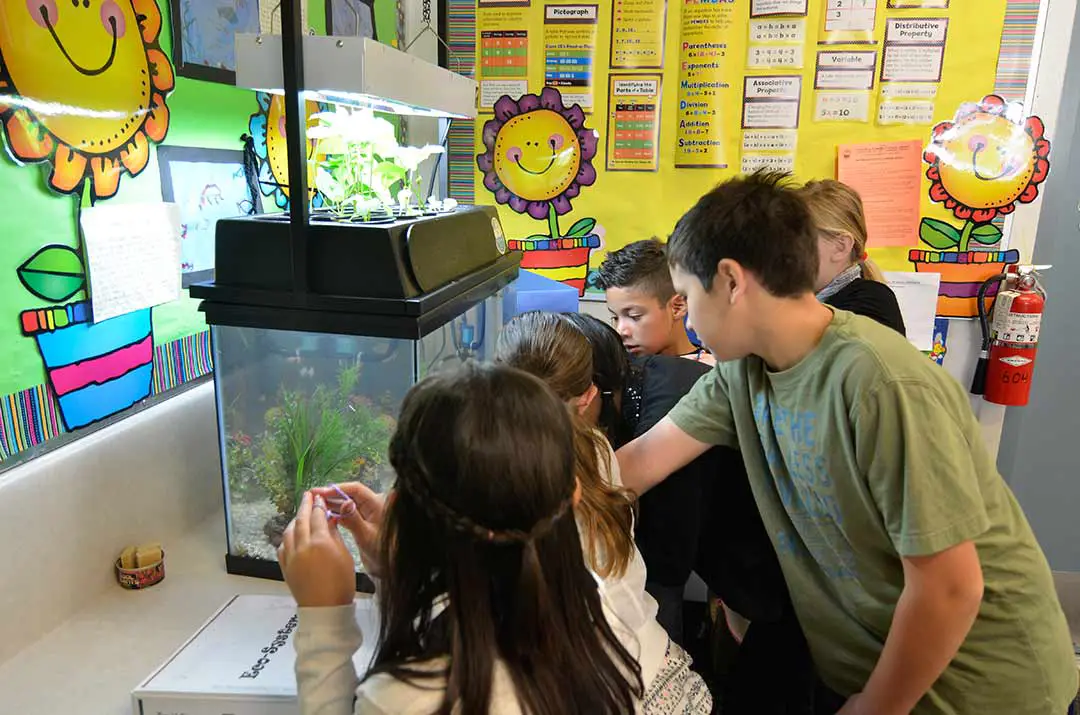ESCONDIDO — The half-dozen or so fish swam blissfully unaware that they’ve been intertwined in a symbiotic relationship with the rows of small leafy green plants sprouting just above them.
But for anyone observing the aquarium, one of nature’s cycles was on full display — the swimming fish and their waste providing nutrients enough for the seeds to sprout and grow, and the plants’ roots filtering the water, providing oxygen enough for the fish to breathe.
Apart from fish food and electricity, nothing else was needed for the process to occur in this way.
“It’s a self-sufficient little loop,” said Morgan Bailey, Ph.D., operations director at ECOLIFE, the Escondido-based nonprofit that has been putting together these aquaponics kits they’re calling the ECO-CYCLE.
The idea behind the kits initially was to try and reach as many people as possible, explained Mike Ready, ECOLIFE’s aquaponics program manager.
Even as aquaponics has been around for a very long time, Ready said they realized it would be difficult to convert people that were already involved in the traditional methods of farming.
Aquaponics is a way of showing a different model of doing things, said Bailey.
And so the nonprofit turned to students around the nation with the idea that the younger minds could view the world and their interactions with the environment differently to form a new foundation of solutions to some of the larger issues facing the next generations.
So far, more than 400 kits have been installed in classrooms around the country, with about 375 of them in San Diego County schools, according to Bailey.
ECOLIFE is donating some of the kits to local schools, including within the Vista Unified School District and in Escondido.
Starting next week, Vista will receive teacher training and 15 kits for use in classrooms around the district.
And later in the year 15 more kits will go into Escondido school classrooms.
Monte Vista Elementary received a kit last year. Their school was the first in Vista’s school district to receive one of the kits, according to the Monte Vista Elementary’s Principal Charlene Smith.
Smith applied for the kit as part of a fifth-grade classroom service-learning project in conjunction with Solutions Farms, also based in Vista.
“The students were investigating different solutions for repurposing fish sediment that collects in the pump,” she said. “And the children actually got to see the plants growing and the fish growing and feeding off of the plants and they got to see the whole cycle.”
The classroom is using the kit once again this year, Smith said.
“It’s real-life experience,” she added. “This brought it right into the classroom and they got to live it everyday…it was practical experience for them.”
Kait Cole, outreach coordinator at ECOLIFE, said, from the teacher’s perspective, the kit is a new tool for them to use. It’s a way to visually learn complex science standards such as the nitrogen cycle and photosynthesis, beyond the textbooks, she added.
Apart from the scientific components being taught is the side benefit of kids learning about healthy eating.
If a student watches kale grow, for instance, Cole explained, they might be more eager to try it, rather than have it show up on a plate in front of them.
“A lot of kids, they don’t necessarily know where their food comes from, especially in urban San Diego areas…and this is giving them the opportunity to grow their own food and actually want to try it and eat it,” she said.
Also at hand comes the lesson of learning how people use their resources, Bailey explained.
“We have to successfully live within our means, particularly within California and with hitting limitations in California with the drought,” he added.
“Using our resources wisely goes far beyond agriculture,” Bailey said. “It goes to our agriculture, it goes to our energy production, it goes to our transportation. If we can get students to think differently about how we utilize and work with our natural systems, I think that can bring a holistic approach to sustainability. We can’t just target agriculture, or transportation, or energy, we have to think differently about all of them.”


